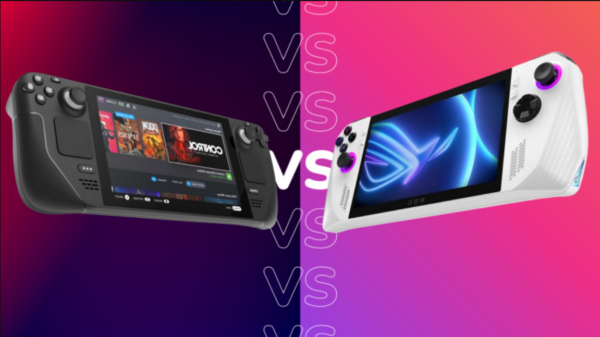This is steadily becoming a crowded market, with the Steam Deck residing at the top of the pecking order, at least in terms of popularity.
So how does the upcoming Asus ROG Ally measure up against the Steam Deck? We haven’t tested the ROG Ally just yet, but we’ve delved into the specs to discover the main differences. Here they are:
The Asus ROG Ally is more potent
According to YouTuber Dave2D, Asus claims that the new ROG Ally portable is 2x more potent than the Steam Deck.
While we can’t verify that claim until testing, it’s not a major surprise given the components propelling the portable. The Asus ROG Ally features a custom 4nm AMD APU, with a Zen 4 CPU and RDNA 3 GPU. We don’t know the clock rates of the new microprocessor just yet, however.
For comparison, the Steam Deck is using a Zen 2 CPU and RDNA 2 GPU, which implies it’s a little behind in terms of component generations.
We don’t know for sure what kind of performance these components are capable of for the ROG Ally, but we’re expecting it to allow games to run at higher graphics settings than the Steam Decks. To get a seamless performance for modern games such as Elden Ring on Steam Deck, you generally have to decrease the resolution or the graphics settings.
Despite the additional performance, Dave2D claims that the Asus ROG Ally actually operates quietly than the Steam Deck, with the latter becoming noticeably noisy when under duress.

The ROG Ally has a 120Hz refresh rate
Both the Steam Deck and Asus ROG Ally have the same 7-inch screen size, but differ significantly when it comes to the specifications of the display.
Most notably, the Asus ROG Ally’s refresh rate peaks out at an impressive 120Hz. This should take advantage of the portable’s weaponry, with games operating at high refresh rates appearing smoother than they would on the 60Hz panel of the Steam Deck.
The ROG Ally also features a higher screen resolution, coming in at 1920×1080, compared to the slightly less pixel-packed 1280×800 panel. Asus has also opted for a 16:9 aspect ratio, which is a little more rectangular than the Steam Deck’s 16:10 counterpart.
And to round it all off, the Asus ROG Ally has a brighter screen, capable of rising up to 500 nits, whereas the Steam Deck is limited to 400 nits.

Steam Deck operates on SteamOS 3.0
The Steam Deck is unique to other gaming portables, as it utilizes SteamOS. This is an operating system created by Valve, and so is closed down to the Steam library and store. Since the Steam Deck operates on Linux, you are able to open a desktop mode to use handheld like a portable PC, but it’s not very user friendly for those more acclimated to Windows.
Speaking of which, the Asus ROG Ally operates on Windows 11, allowing for more flexibility in terms of software. You’ll be able to use a browser just like a standard laptop or desktop or even open up applications such as Game Pass and GeForce Experience.
Asus has also created a custom version of its Armoury Crate app which should load up by default, allowing you to start up games and alter settings effortlessly. Although it may not be quite as smooth as SteamOS or the Nintendo Switch interface. We’ll have to wait for testing to find out.
The Steam Deck has touchpads
The Asus ROG Ally has an essentially comparable control setup as the Steam Deck. Both feature dual analogue sticks, a D-pad, shoulder buttons and triggers, front-facing buttons and even back buttons – although the Steam Deck has an additional pair of the latter.
Not much separates the two in terms of inputs then, but those who like trackpads may be sorry to see them omitted on the ROG Ally. The Steam Deck’s trackpads aren’t quite precise enough to supplant a gaming mouse for controlling first-person shooters and the like, but we still found them fairly useful for menu navigation in the likes of Football Manager.
There isn’t a significant difference for ports either, both donning a microSD card slot for storage expansion and a headphone input. The ROG Ally claims a minor advantage with a fingerprint sensor though, which could come in useful for logging into Windows.
The ROG Ally also has a connection interface for Asus’ XG mobile GPU, which is an external graphics solution that can enhance the performance even further. This doesn’t come with the Ally, and is a very expensive accessory, but is still pleasant to have the option.
Asus ROG Ally will undoubtedly be more costly
Asus hasn’t announced the price of the ROG Ally just yet, so we don’t really have an estimate of how much it will cost. However, we expect the ROG Ally to be substantially more expensive than the Steam Deck due to specifications.
With Asus claiming its portable is 2x more potent than the Steam Deck, as well as having a screen with a higher refresh rate, it’s going to cost a lot more to manufacture.
We really wouldn’t be astonished if Asus’ portable approaches the $1000/£1000 mark, which will likely make it too expensive for the overwhelming majority of gamers. But let’s hope we’re incorrect, as it would be wonderful to see a price that challenges the affordability of the $399/£349 Steam Deck.

